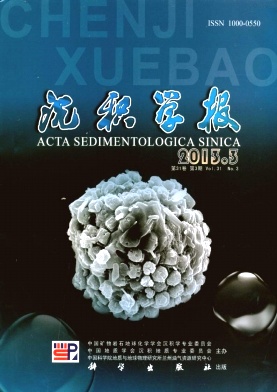Cementation of the Ordovician Carbonate Reservoirs in the South Ordos Basin, China
- Publish Date: 2013-06-10
-
Key words:
- south Ordos basin /
- cementation /
- carbon and oxygen isotopes /
- trace elements /
- fluid inclusions
Abstract: The Ordovician Majiagou Formation mainly consists of carbonate rocks originally deposited and karst bareccia. The reservoir space is mainly secondary pores. After deposition dissolution, dolomitization, desiccation, physical compaction, karstification and cementation soon began. Cementation, which mainly occurred under the burial conditions after the middle Carboniferous, is common and important destructional dianenesis for reservoirs. The micritic, equant sparry and poikilotopic calcite and dolomite, infilling moldic pores of anhydrite concretion, and nonfabric selective dissolution pores and fractures, are common cements. The δ18O and δ13C values of micritic dolomite range from 10.98‰ to 0.8‰, averaging 5.54‰; and from 4.76‰ to 5.77‰, averaging 1.51‰, respectively. The δ18O and δ13C values of dolomite cements infilling dissolution pores range from 12.54‰ to 2.67‰, averaging 7.34‰; and from 5.56‰ to 3.48‰, averaging 0.28‰ respectively. The δ18O and δ13C values of calcite cements infilling dissolution pores range from 15.42‰ to 6.02‰, averaging 9.51‰; and from 12.44‰ to 1.33‰, averaging 3.20‰, respectively. The δ18O and δ13C values of dolomite and calcite cements are generally lower than of micritic dolomite, because of late formation, fresh water leaching, burial diagenesis and influence of organic materials. The Na, Sr, Fe and Mn content of micritic dolomite, dolomite cements and calcite cements ranges from 0 to 350 μg/g, averaging 59 μg/g; from 0 to 380 μg/g,averaging 10 μg/g; from 0 to 14 570 μg/g, averaging 1 040μg/g; and from 0 to 4 670 μg/g, averaging 183 μg/g, respectively. The Na, Sr, and Mn content of dolomite and calcite cements is similar with that of micritic dolomite, because all trace elements content is low. Fe content of dolomite and calcite cements is higher than that of micritic dolomite. The homogenization temperatures of fluid inclusions in the cements range 90~140℃. All indicates that the cements formed under reduced conditions with high temperature in the deep burial environments. The most gaseous phase of the fluid inclusions consists of CH4, while the most liquid phase is H2O. The early and late cements formed before and later formation of the natural gas respectively. The cementation developed extensively in the kart depressions.
| Citation: | Cementation of the Ordovician Carbonate Reservoirs in the South Ordos Basin, China[J]. Acta Sedimentologica Sinica, 2013, 31(3): 527-535. |






 DownLoad:
DownLoad: